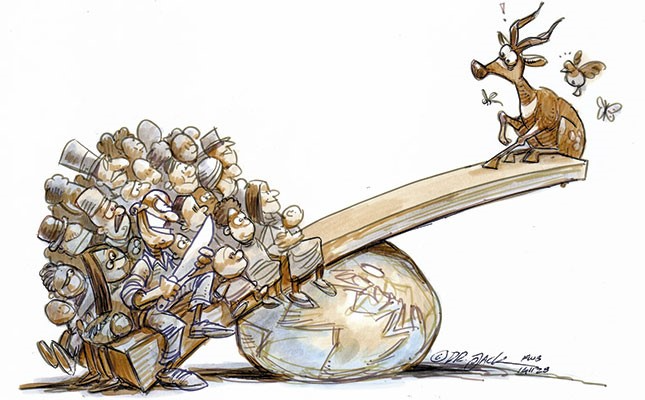The Great Indian Kitchen revolves around a newly married husband and wife, living in her husband’s house with the husband’s father and mother. Everything looked alright in the house outside. The main focus of the movie was mainly in the kitchen where the wife (Nimisha) and her husband’s mother were working. Later, the wife was struggling in the kitchen alone and understood that she didn’t need to tolerate anymore injustice and got out of the house and started following her dream.
Story outline:
The film starts with Nimisha in a dance class. We can see that she’s happy and has a smile on her face. Food is prepared at Nimisha’s house as the family is preparing for a pennu kaanal (a potential groom coming to see a girl for an arranged marriage). She is married to a man, which is a properly arranged marriage, and becomes the bride of his old tharavad house. It is a very traditional and patriarchal family. The newly bride arrives in her new home, where her routine as a wife and daughter-in-law. The next day , she comes into the kitchen to help her mother-in-law. The family is so patriarchal that her mother-in-law hands the toothbrush to her husband so that he can brush the teeth. Whenever the father-in-law goes out , the mother-in-law takes his chappal and gives it to him. Women will be doing household work while men will be reading newspapers, using phones, or doing yoga. Men eat meals first and leave the table mess by putting all the waste there itself and leaving the table. They are not concerned about how women will eat food in the same place . We can see that her mother-in-law is having food on the same plate where father-in-law had food . The new bride is trying to adjust to her new surroundings. Her mother-in-law went to take care of her pregnant daughter. After that, the Nimisha started to do a domestic routine. The responsibility of cooking, cleaning, and household chores is done by her. She is unpleasant with kitchen situations such as leaking tapes. Her husband is not considering her needs and feelings. She is telling him that he is actually hurting her while having sex and asking for foreplay. Her father-in-law forbids her from going for a job. He says that women bring prosperity to the family if they stay at home . The job done by wives is better than the work done by ministers and bureaucrats. The attitudes of the family towards menstruation are not really good. During her menstruation, she is asked to sleep on the floor in a separate room, bathe in the river, eat separately, not leave the room, and wash everything she touches. Kerala is grappling with the Sabarimala temple verdict where the courts decided that menstruation is not an impurity and so women should be allowed to visit the temple. A lot of people, including the husband’s family, do not approve of the verdict.
One day, when husband fell down from a scooter, the wife touched the husband. He pushed her away and said that she made him impure. We can see that he is asking Swami how he can regain his purity, and Swami is saying that he should dip in the river. One day, out of anger and frustration, the wife throws dirty sink water on her husband and father-in-law and leaves the family for her independence, freedom, and dignity. As the film ends, we can see that she has become a dance teacher her ex-husband is married again; and the second wife seems to have the same fate.
Great Indian kitchen trires to show following sociological aspects:
- Patriarchy
- Purity
- Spaces
- Gender inequality/sexism
- Sex
- Traditional family and modern/ nuclear family
- Values/Custom
- Religion
- Caste system
- Dowry system
Great Indian kitchen (Mahaththaya Bharatiya Adukkala) shows about patriarchy system exist in Indian society, and it tries to show what is happening in Indian households. Indian married women’s lives and their roles in the kitchen .Film is trying to ask each and every person how we are treating women in our homes. The movie talks about Indian woman’s, it can be you, your mother or grandmother or aunties. The movie show the life of newly married women to a man, who is a sociology teacher and from a prestigious (upper caste) family, and they had an arranged marriage. Later it shows how wife is doing all the household works, ideas of grooms family honor and their customs and traditions. Patriarchy is the male domination of women in the public and private spheres of the society and the unequal power relationship between male and female.Females can be seen in the kitchen or attending the men.
Women in house chops, slices, dices and grinds, and she cooks washes, wipes, sweeps and swabs whereas men are lazing around, scrolling through videos in whatsapp and doing yoga before breakfast. In the house, we can see that women in the house should give a toothbrush to father-in-law, who is sitting and reading newspapers on the porch. Wife should give husband’s chappal when he is stepping out of the house. Men will be having food first in the house and leave behind food waste on the dinning table for women to clean. Women are having same plate to have food which is used by husband. Women every day deal with trash and kitchen waste. Men are enjoying and having good rest.The women are constantly on the go, running into each other, serving food, doing other household tasks, etc.
One of the scene we can see that nimisha is asking mother-in-law about the side dishes for dosa, and says that in their home, they need to make sambhar and chamandhi and that the chamandhi needs to be hand ground because the patriarch of the house, the father-in-law, only likes it that way. The daughter-in-law says that in her parental house, they would only make one side dish.(She is from a non-resident Indian (NRI) family (her father was employed in the Gulf, educated girl).
In these we can see that, father is asking daughter-in-law to bring toothbrush, cook rice in fire wood and wash clothes by hand instead of using washing machine. So father-in- law still follow old custom. Remember, gender inequality start from home itself. The couple went to a friend’s house, his wife told that she and her daughter will sit later while son is already eating at the table. These show, how young girls are enslaved to patriarchy.
Men exercise and women pick up garbage and lighting holy lamp. She is the first one to wake up in home and last one to sleep at night. Raped by men at night whom she is legally and socially bounded. Wife is portrait as cook, cleaner, all round housemaid and sex slave. These are the reality and patriarchy enslaved women.
The movie shows how the father-in-law is a patriarch and expects women to do all the household chores and take care of kids. Moreover, he disapproves of machines and gadgets. He believes that women’s work in the home is considerably more important than that of bureaucrats and ministers, Nimisha’s father-in-law advises her to give up on her desire to seek for jobs.
Here women are punished through gentle but brutal rebukes for eg: In hotel she gave comments on husband table manners and bedroom she hints at foreplay that time her husband uses muted violence. Women’s sexual needs and freedom are not addressed in India society. In movie, we can see that women feel discomfort and pain during intercourse. Oppressed women never question men’s authority and traditions.
Dowry system presence can be seen where groom is getting car from bride family and all the jewelry of the bride is handover to the father-in-law. These indicate, he is having absolute control on house.
Groom is having a patriarchy family structure and follow old tradition of the ancestral home. Whereas bride is coming from nuclear family and non-resident Indian (NRI) family (her father was employed in the Gulf), educated, good in computers, interested in dancing, and hopeful of finding a job. Family not strictly following religious beliefs, custom and practices. Home is more modern with progressive ideas.
In the movie, they are showing modern family, where husbands are cooking for women and women are cooking English breakfast and using modern kitchen technologies such as toaster.
Gender Spaces:
There is gender space for movement of men and women, have their own respective areas and domains. Veranda, drawing room are where men will be dominated, and also they have connected with outside world. During the wedding we can see that most of the men were talking in veranda and drawing room and dining room is for family matters and women will be there, but they will be silent and just witness what is happening. Men will be seen in semisocial spaces of the house, women will be mainly in kitchen or with domestic gaze. Men will rarely come to the kitchen. For eg husband come to kitchen 3 times when he married firstly, second time, when he wanted tea, third time after second marriage and father-in-law once.Men can be seen in public areas such as school, temple etc. whereas women are having limited interaction with outside world.
Caste system can be seen here the maid saying that earlier lower caste people are not allowed to enter into these house (upper caste house) during her mother’s time, they only work outside the these houses.
We can see the large ancestral house of the husband and his family, a home that always seems to run smoothly and looks spotlessly clean. Large house represent family’s name, prestige, and its tradition and women are responsible for cleaning. Women are responsible for the home and family, whilst men are just concerned with themselves.
Idea of purity vs impurity:
Purity are usually associated with the male characters, and ideas of impurity are associated with the women.Men begin the day by purifying either their body (religious ablutions, brushing their teeth, etc.) or their thoughts (yoga, reading the morning newspaper). Whereas women are shown wearing clothes that are stained with sweat; bathing usually happens at the end of the day after all the domestic work is done, and The wife obsessively washes her hand with soap to remove the smell of food waste and other chores.The only time she is depicted washing throughout the day without considering the kitchen is when she is requested to do a ritual ablution to purify her body after her period.
Wife and the servant cleaning, sweeping, wiping, polishing and scrubbing, and disposing of dirt and waste. Even though these women clean the house, they are considered as impure and consider as untouchables during menstruation.
During the first time wife told to husband that she is having periods, that time he told no to cook and don’t do any work because she is polluted by menstruation. The contradictions of these is, he is Sociology teacher, we can see that he is teaching about family. Regressive practices and religious patriarchy surrounding menstruation are shown in this movie, the wife is asked to sleep separately, and not touch any bedding or clothes herself as she would ‘contaminate’ .
She is not permitted to show her face to the family’s men who are traveling to Sabarimala (a religious pilgrimage for the Hindu deity, Iyyappan), because she is not pure, whereas the “swami” men are. And also not allowed to go to kitchen also. We can see narrow-minded attitude towards menstruation. The menstruating women touch her husband when he had an accident. He is shown speaking to a religious advisor and list a few traditional practices that the pilgrim is supposed to take if they are ‘polluted’ by a menstruating woman. And advisor give a simple task, that is dip in river. Men’s traditions and customs evolve with time.
Wife find hard adjust with husband family. Out of frustration, she moves out of the house and become an independent dance teacher. These shows finally women are outside the home with liberation and freedom.
Trash in this movie symbolizes the institution of patriarchy, which the women have to endure every day. It shows patriarchy of men are not going to end. At the end, we can see the groom remarried again, and this wife wants to face all the patriarchy custom and traditions.
Ms. Alphonsa (assistant professor)










